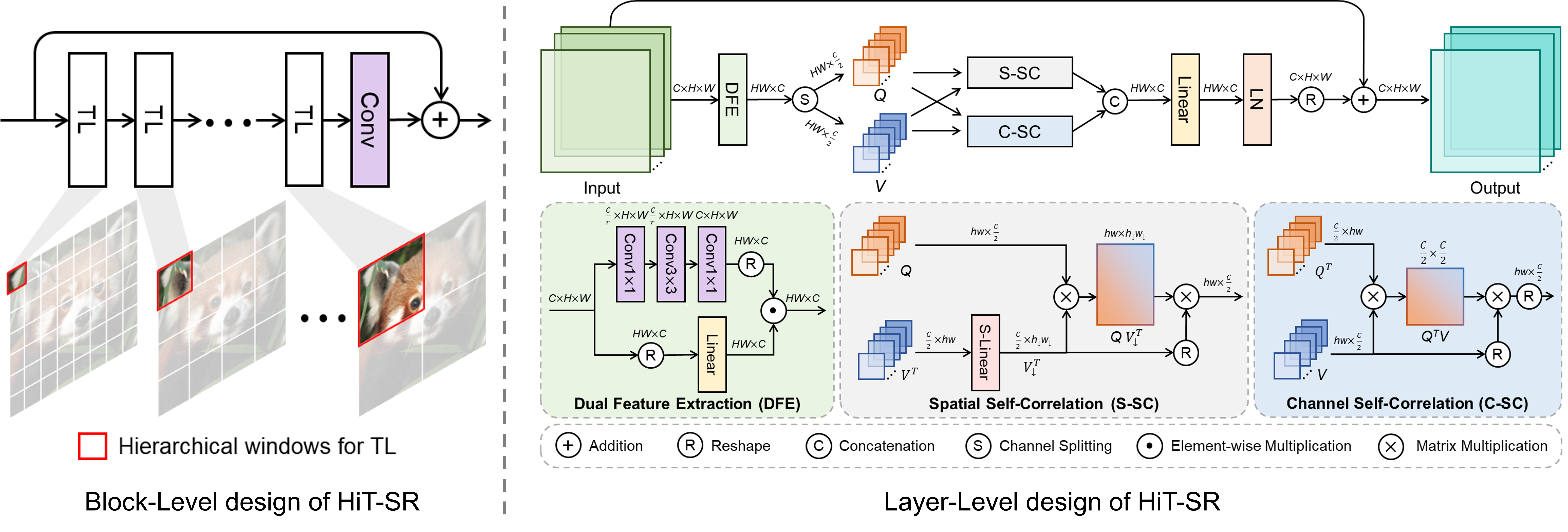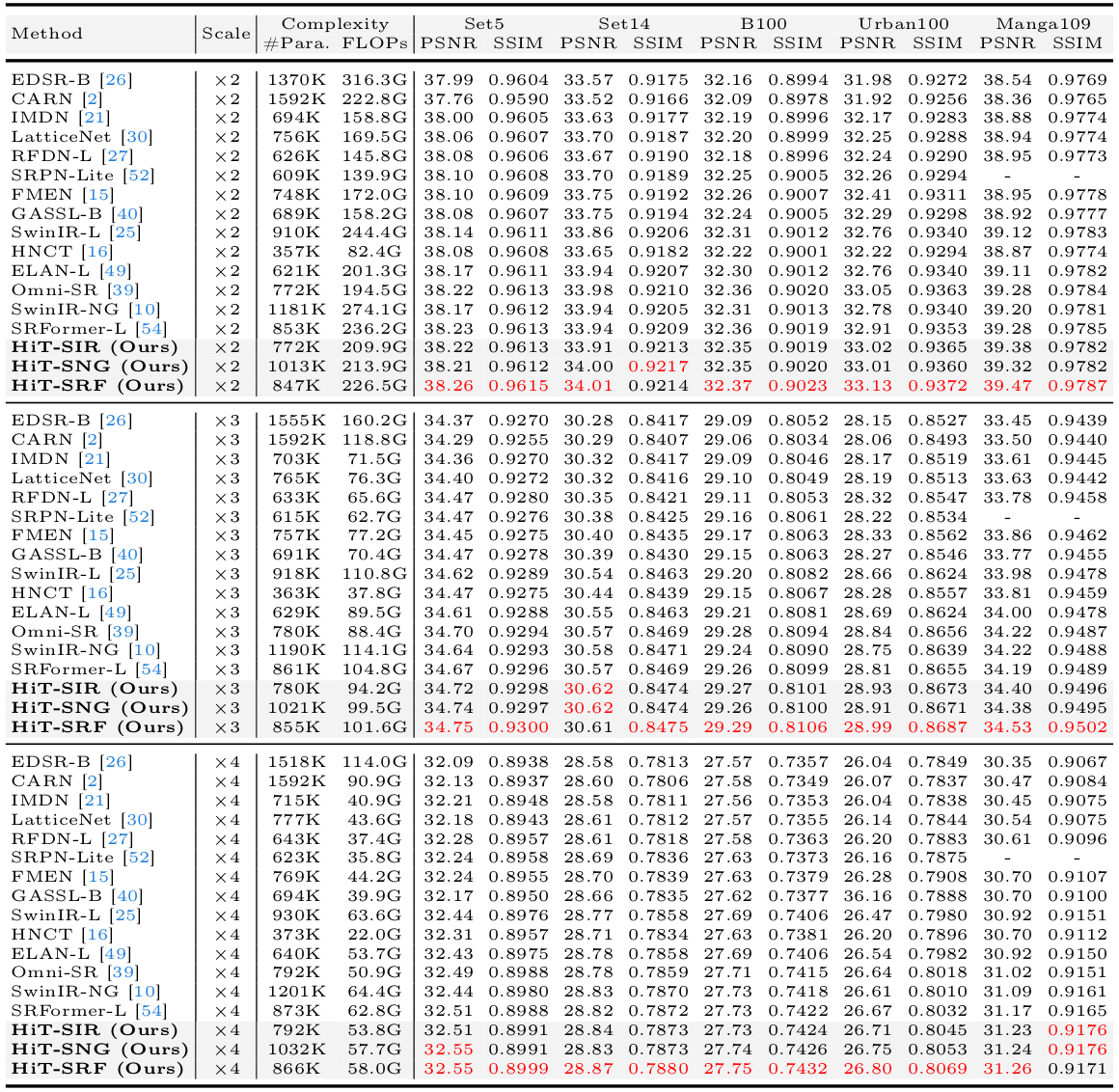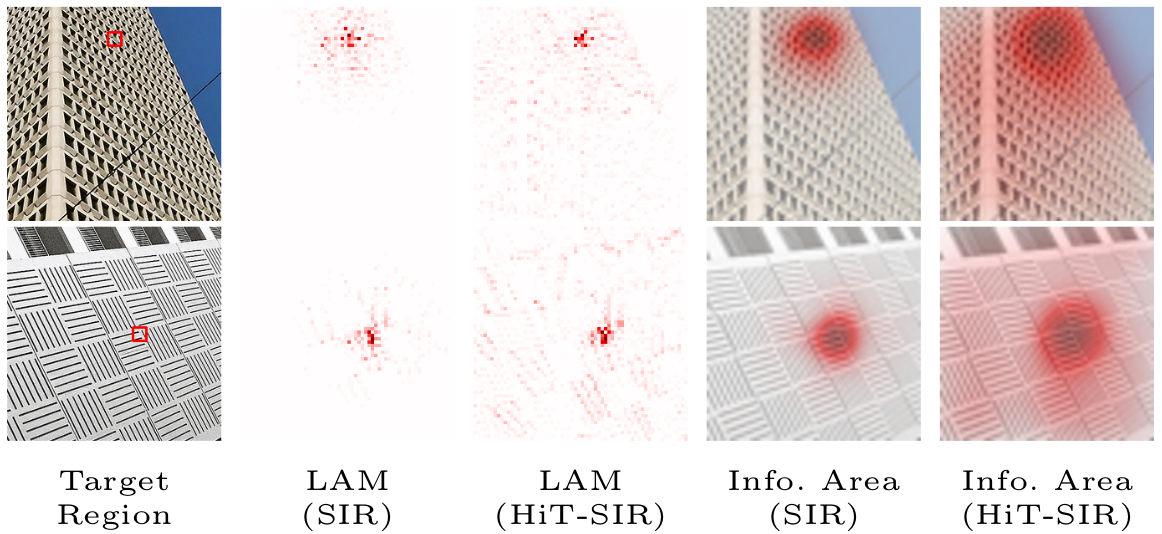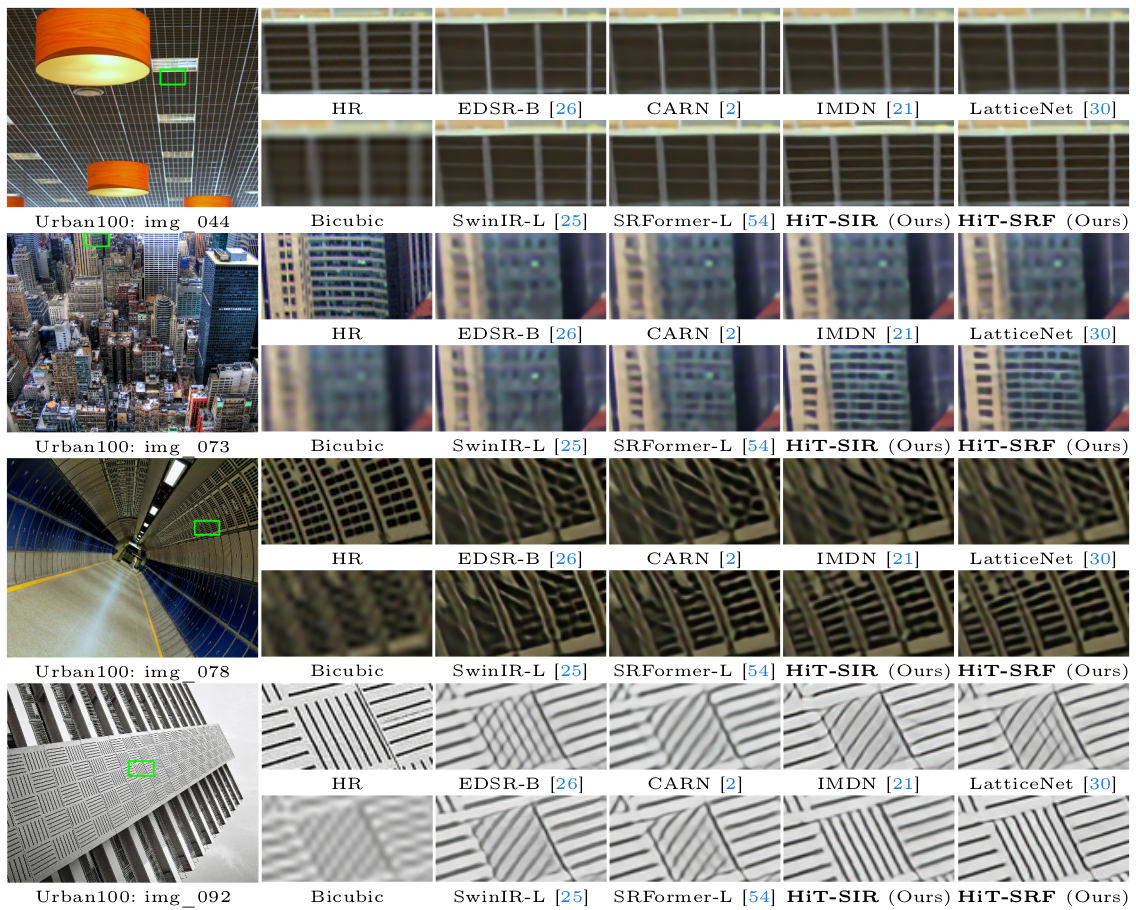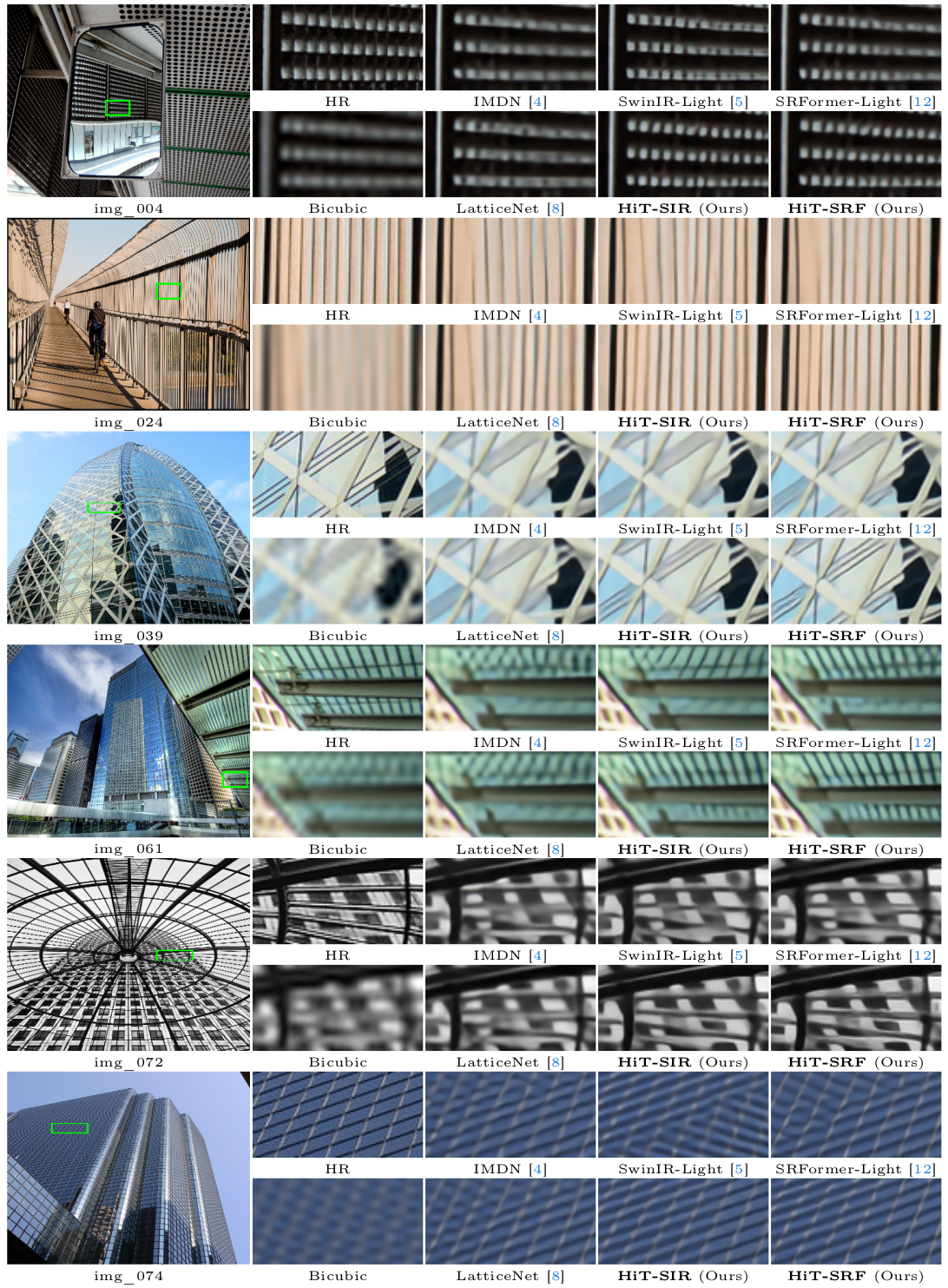Xiang Zhang1 · Yulun Zhang2 · Fisher Yu1
1ETH Zürich 2MoE Key Lab of Artificial Intelligence, Shanghai Jiao Tong University
[Paper] | [Supp] | [Video] | [🤗Hugging Face] | [Visual Results] | [Models]
Abstract: Transformers have exhibited promising performance in computer vision tasks including image super-resolution (SR). However, popular transformer-based SR methods often employ window self-attention with quadratic computational complexity to window sizes, resulting in fixed small windows with limited receptive fields. In this paper, we present a general strategy to convert transformer-based SR networks to hierarchical transformers (HiT-SR), boosting SR performance with multi-scale features while maintaining an efficient design. Specifically, we first replace the commonly used fixed small windows with expanding hierarchical windows to aggregate features at different scales and establish long-range dependencies. Considering the intensive computation required for large windows, we further design a spatial-channel correlation method with linear complexity to window sizes, efficiently gathering spatial and channel information from hierarchical windows. Extensive experiments verify the effectiveness and efficiency of our HiT-SR, and our improved versions of SwinIR-Light, SwinIR-NG, and SRFormer-Light yield state-of-the-art SR results with fewer parameters, FLOPs, and faster speeds (~7x).
- 2024-09: 🤗HiT-SR is available at 🤗Hugging Face. Thank Niels!
- 2024-08: 🧑💻HiT-SRF is available at neosr. Thank muslll!
- 2024-07: 🎉HiT-SR is accepted by ECCV 2024! This repo is released.
- Python 3.8
- PyTorch 1.8.0 + Torchvision 0.9.0
- NVIDIA GPU + CUDA
git clone https://github.com/XiangZ-0/HiT-SR.git
conda create -n HiTSR python=3.8
conda activate HiTSR
pip install -r requirements.txt
python setup.py developTraining and testing sets can be downloaded as follows:
| Training Set | Testing Set | Visual Results |
|---|---|---|
| DIV2K (800 training images, 100 validation images) [organized training dataset DIV2K: One Drive] | Set5 + Set14 + BSD100 + Urban100 + Manga109 [complete testing dataset: One Drive] | One Drive |
Download training and testing datasets and put them into the corresponding folders of datasets/. See datasets for the detail of the directory structure.
| Method | #Param. (K) | FLOPs (G) | Dataset | PSNR (dB) | SSIM | Model Zoo | Visual Results |
|---|---|---|---|---|---|---|---|
| HiT-SIR | 792 | 53.8 | Urban100 (x4) | 26.71 | 0.8045 | One Drive | One Drive |
| HiT-SNG | 1032 | 57.7 | Urban100 (x4) | 26.75 | 0.8053 | One Drive | One Drive |
| HiT-SRF | 866 | 58.0 | Urban100 (x4) | 26.80 | 0.8069 | One Drive | One Drive |
The output size is set to 1280x720 to compute FLOPs.
-
Download training (DIV2K, already processed) and testing (Set5, Set14, BSD100, Urban100, Manga109, already processed) datasets, place them in
datasets/. -
Run the following scripts. The training configuration is in
options/Train/.# HiT-SIR, input=64x64, 4 GPUs python -m torch.distributed.launch --nproc_per_node=4 --master_port=1234 basicsr/train.py -opt options/Train/train_HiT_SIR_x2.yml --launcher pytorch python -m torch.distributed.launch --nproc_per_node=4 --master_port=1234 basicsr/train.py -opt options/Train/train_HiT_SIR_x3.yml --launcher pytorch python -m torch.distributed.launch --nproc_per_node=4 --master_port=1234 basicsr/train.py -opt options/Train/train_HiT_SIR_x4.yml --launcher pytorch # HiT-SNG, input=64x64, 4 GPUs python -m torch.distributed.launch --nproc_per_node=4 --master_port=4321 basicsr/train.py -opt options/Train/train_HiT_SNG_x2.yml --launcher pytorch python -m torch.distributed.launch --nproc_per_node=4 --master_port=4321 basicsr/train.py -opt options/Train/train_HiT_SNG_x3.yml --launcher pytorch python -m torch.distributed.launch --nproc_per_node=4 --master_port=4321 basicsr/train.py -opt options/Train/train_HiT_SNG_x4.yml --launcher pytorch # HiT-SRF, input=64x64, 4 GPUs python -m torch.distributed.launch --nproc_per_node=4 --master_port=1234 basicsr/train.py -opt options/Train/train_HiT_SRF_x2.yml --launcher pytorch python -m torch.distributed.launch --nproc_per_node=4 --master_port=1234 basicsr/train.py -opt options/Train/train_HiT_SRF_x3.yml --launcher pytorch python -m torch.distributed.launch --nproc_per_node=4 --master_port=1234 basicsr/train.py -opt options/Train/train_HiT_SRF_x4.yml --launcher pytorch
-
The training experiments will be stored in
experiments/.
-
Download the pre-trained models and place them in
experiments/pretrained_models/.We provide pre-trained models for efficient image SR: HiT-SIR, HiT-SNG, and HiT-SRF (x2, x3, x4).
-
Download testing datasets (Set5, Set14, BSD100, Urban100, Manga109), place them in
datasets/. -
Run the following scripts. The testing configuration is in
options/Test/(e.g., test_HiT_SIR_x2.yml).Note 1: You can set
use_chop: True(default: False) in YML to chop the image for testing.# No self-ensemble # HiT-SIR, reproduces results in Table 2 of the main paper python basicsr/test.py -opt options/Test/test_HiT_SIR_x2.yml python basicsr/test.py -opt options/Test/test_HiT_SIR_x3.yml python basicsr/test.py -opt options/Test/test_HiT_SIR_x4.yml # HiT-SNG, reproduces results in Table 2 of the main paper python basicsr/test.py -opt options/Test/test_HiT_SNG_x2.yml python basicsr/test.py -opt options/Test/test_HiT_SNG_x3.yml python basicsr/test.py -opt options/Test/test_HiT_SNG_x4.yml # HiT-SRF, reproduces results in Table 2 of the main paper python basicsr/test.py -opt options/Test/test_HiT_SRF_x2.yml python basicsr/test.py -opt options/Test/test_HiT_SRF_x3.yml python basicsr/test.py -opt options/Test/test_HiT_SRF_x4.yml
-
The output is stored in
results/. All visual results of our pre-trained models can be accessed via one drive.
-
Download the pre-trained models and place them in
experiments/pretrained_models/.We provide pre-trained models for efficient image SR: HiT-SIR, HiT-SNG, and HiT-SRF (x2, x3, x4).
-
Put your dataset (single LR images) in
datasets/single. Some example images are in this folder. -
Run the following scripts. The testing configuration is in
options/test/(e.g., test_single_x2.yml).Note 1: The default model is HiT-SRF. You can use other models like HiT-SIR by modifying the YML.
Note 2: You can set
use_chop: True(default: False) in YML to chop the image for testing.# Test on your dataset without ground-truth images python basicsr/test.py -opt options/Test/test_single_x2.yml python basicsr/test.py -opt options/Test/test_single_x3.yml python basicsr/test.py -opt options/Test/test_single_x4.yml -
The output is stored in
results/.
We apply our HiT-SR approach to improve SwinIR-Light, SwinIR-NG and SRFormer-Light, corresponding to our HiT-SIR, HiT-SNG, and HiT-SRF. Compared with the original structure, our improved models achieve better SR performance while reducing computational burdens.
- Performance improvements of HiT-SR (SIR, SNG, and SRF indicate SwinIR-Light, SwinIR-NG, and SRFormer-Light, respectively).
- Efficiency improvements of HiT-SR (SIR, SNG, and SRF indicate SwinIR-Light, SwinIR-NG, and SRFormer-Light, respectively). The complexity metrics are calculated under x2 upscaling on an A100 GPU, with the output size set to 1280x720.
- Overall improvements of HiT-SR
- Convergence improvements of HiT-SR
More detailed results can be found in the paper. All visual results of can be downloaded here.
More results (click to expan)
- Quantitative comparison
- Local attribution map (LAM) comparison (more marked pixels indicate better information aggragation ability)
- Qualitative comparison on challenging scenes
If you find the code helpful in your research or work, please consider citing the following paper.
@inproceedings{zhang2024hitsr,
title={HiT-SR: Hierarchical Transformer for Efficient Image Super-Resolution},
author={Zhang, Xiang and Zhang, Yulun and Yu, Fisher},
booktitle={ECCV},
year={2024}
}
This project is built on DAT, SwinIR, NGramSwin, SRFormer, and BasicSR. Special thanks to their excellent works!

